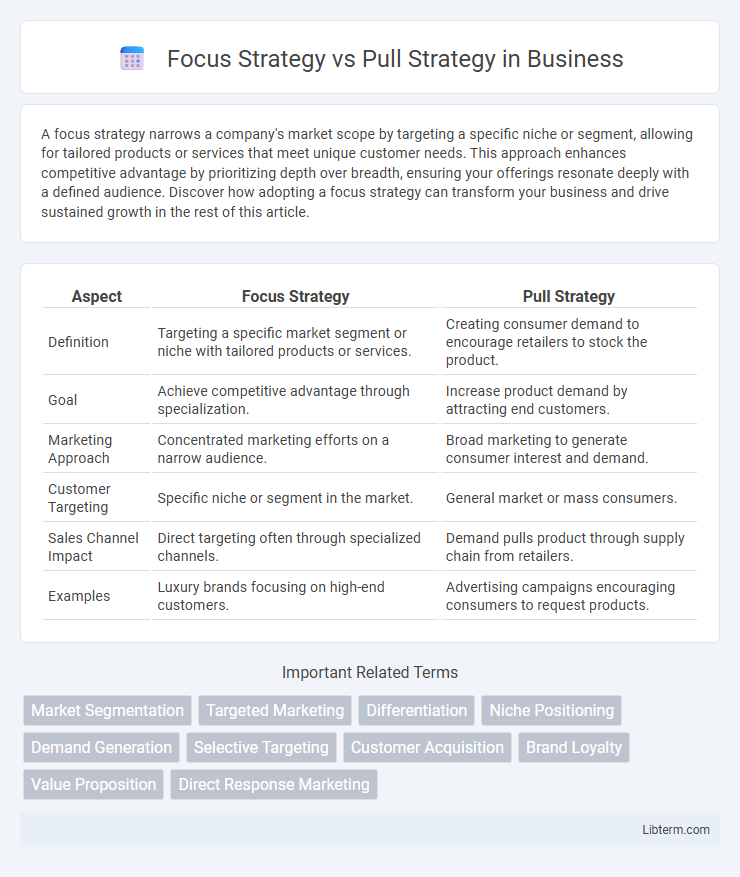A focus strategy narrows a company's market scope by targeting a specific niche or segment, allowing for tailored products or services that meet unique customer needs. This approach enhances competitive advantage by prioritizing depth over breadth, ensuring your offerings resonate deeply with a defined audience. Discover how adopting a focus strategy can transform your business and drive sustained growth in the rest of this article.
Table of Comparison
| Aspect | Focus Strategy | Pull Strategy |
|---|---|---|
| Definition | Targeting a specific market segment or niche with tailored products or services. | Creating consumer demand to encourage retailers to stock the product. |
| Goal | Achieve competitive advantage through specialization. | Increase product demand by attracting end customers. |
| Marketing Approach | Concentrated marketing efforts on a narrow audience. | Broad marketing to generate consumer interest and demand. |
| Customer Targeting | Specific niche or segment in the market. | General market or mass consumers. |
| Sales Channel Impact | Direct targeting often through specialized channels. | Demand pulls product through supply chain from retailers. |
| Examples | Luxury brands focusing on high-end customers. | Advertising campaigns encouraging consumers to request products. |
Understanding Focus Strategy: Definition and Core Principles
Focus Strategy centers on targeting a specific market niche to deliver tailored products or services that meet the unique needs of a distinct customer segment. Core principles include specialization, competitive advantage through deep market knowledge, and concentrating resources on serving a narrow audience more effectively than broader competitors. This strategy emphasizes differentiation or cost leadership within the chosen niche to achieve superior market positioning.
What is Pull Strategy? Key Concepts and Mechanisms
Pull strategy is a marketing approach that aims to create consumer demand by encouraging customers to actively seek out a product or service. Key concepts include building brand awareness, generating interest through advertising and promotions, and leveraging social media to engage and attract target audiences. The mechanism relies on stimulating demand at the consumer level, prompting retailers to stock the product based on customer requests.
Focus Strategy vs Pull Strategy: Key Differences
Focus Strategy targets a specific market segment or niche by tailoring products and marketing efforts to meet unique customer needs, enhancing brand loyalty and competitive advantage within that segment. Pull Strategy, in contrast, generates consumer demand through mass media and promotional campaigns, encouraging customers to actively seek out the product from retailers. The key difference lies in Focus Strategy's emphasis on specialized targeting versus Pull Strategy's broad demand creation across wider audiences.
Market Segmentation in Focus Strategy vs Pull Strategy
Focus Strategy targets specific market segments by tailoring products or services to meet the unique needs of these groups, enhancing customer loyalty and competitive advantage. Pull Strategy emphasizes creating strong consumer demand within broad target markets, often through advertising and promotions, to encourage retailers to stock the product. Market segmentation in Focus Strategy involves identifying niche segments with distinct preferences, while Pull Strategy relies on mass-market appeal to stimulate demand across wider demographics.
Customer Targeting Approaches: Niche Focus vs Broad Appeal
Focus Strategy targets a specific niche market with tailored products or services that meet distinct customer needs, enhancing brand loyalty and competitive advantage within that segment. Pull Strategy aims to generate broad appeal by creating strong demand through marketing efforts that encourage customers to actively seek the product, leveraging mass communication channels. Businesses adopting a niche focus excel in personalized customer experiences, while broad appeal strategies prioritize widespread visibility and accessibility.
Pros and Cons of Focus Strategy
Focus strategy targets a specific market segment, allowing businesses to tailor products and marketing efforts for higher customer loyalty and reduced competition. This strategy offers advantages such as improved specialization, deeper understanding of customer needs, and often higher profit margins. However, its drawbacks include dependence on a narrow market, vulnerability to changing customer preferences, and limited growth potential if the target segment shrinks.
Pros and Cons of Pull Strategy
Pull strategy leverages customer demand to drive product sales through targeted marketing, fostering strong brand loyalty and reduced inventory costs. It can lead to slower initial market penetration and requires substantial investment in consumer engagement and brand awareness. Reliance on consumer initiation may limit control over sales timing and volumes compared to more direct push approaches.
When to Use Focus Strategy in Business
The Focus Strategy is most effective for businesses targeting a specific market niche with unique needs, allowing deeper customer understanding and tailored offerings. It is ideal when competing against larger firms by leveraging specialized expertise and limited resources to dominate a narrow segment. Companies should adopt the Focus Strategy when market segments are distinct, and differentiation or cost advantages can be achieved by concentrating on particular customer groups or product lines.
Ideal Scenarios for Implementing Pull Strategy
Pull strategy is ideal in scenarios where customer demand is high and the product has strong brand recognition, prompting consumers to actively seek it out. It works best for innovative products, seasonal items, or new market launches where creating desire and awareness drives sales. This approach is effective when businesses want to build long-term brand loyalty and reduce inventory costs by producing only in response to actual demand.
Combining Focus and Pull Strategies: Best Practices and Examples
Combining focus and pull strategies involves targeting a specific market segment while actively engaging customers to initiate purchasing decisions through personalized content and social media interaction. Best practices include leveraging data analytics to identify niche audiences and creating compelling, value-driven campaigns that resonate with their needs, driving organic demand and brand loyalty. Examples of successful integration feature brands like Tesla, which targets eco-conscious consumers and uses direct customer engagement via online platforms to stimulate interest and sales.
Focus Strategy Infographic

 libterm.com
libterm.com